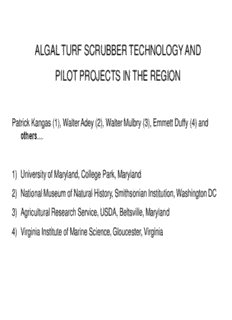
ALGAL TURF SCRUBBER TECHNOLOGY AND PILOT PROJECTS IN THE REGION PDF
Preview ALGAL TURF SCRUBBER TECHNOLOGY AND PILOT PROJECTS IN THE REGION
ALGAL TURF SCRUBBER TECHNOLOGY AND PILOT PROJECTS IN THE REGION Patrick Kangas (1), Walter Adey (2), Walter Mulbry (3), Emmett Duffy (4) and others… 1) University of Maryland, College Park, Maryland 2) National Museum of Natural History, Smithsonian Institution, Washington DC 3) Agricultural Research Service, USDA, Beltsville, Maryland 4) Virginia Institute of Marine Science, Gloucester, Virginia Algae are fast-growing, photosynthetic microorganisms that absorb nutrients and produce valuable biochemical byproducts. . . In this presentation a technology is described that utilizes the controlled growth of algae as the driving force for a best management practice… Our work focuses on a patented technology, the algal turf scrubber, that has proven to be reliable and effective as a tool for nutrient removal from a waterbody. The algal turf scrubber (ATS) utilizes native algae that grow attached to a screen in a shallow, flowing water system. This technology contrasts with most algal growth systems that utilize suspended algae instead of attached algae. One advantage of the ATS is that attached algae are easier to harvest than suspended algae. Eutrophication in the Chesapeake Bay is associated with out-of-control algal growth. However, the algal turf scrubber technology relies on controlled algal growth! The ATS technology has been implemented at the large scale in Florida and Texas and we are now hoping to scale-up from experimental studies that have been conducted throughout the Chesapeake Bay watershed… We envision the algal turf scrubber as the basis of a green economy that cleans polluted water and provides a valuable byproduct that can be used as a feedstock for biofuels or for other useful products. Nutrient removal by the algal turf scrubber is calculated as follows: Nutrient removal rate = biomass production rate x nutrient content of biomass grams nutrient/m2/day grams dry weight/m2/day grams nutrient/grams dry weight Typical biomass production rates range from 5 – 30 grams dry weight/m2/day and typical nutrient contents are 3-5% nitrogen and 0.3-0.5% phosphorus. We’ve operated experimental algal turf scrubbers all around the bay as noted on the map to the right. Data has been gathered at least over an annual cycle at each of these sites. Walter Mulbry of USDA has operated scrubbers for more than a decade…
Description: